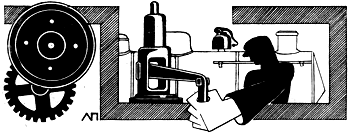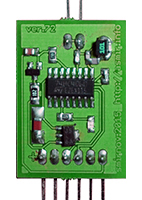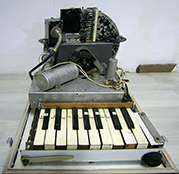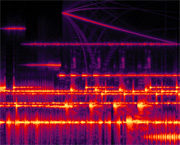| |
|
 |
| |
|
| |
 The Theremin Kitchen Workshop The Theremin Kitchen Workshop
=1-5 days with final concert-presentation of results=
This intensive workshop offers hands-on introduction to interactive systems, based on the same principle as a well known electronic musical instrument the Theremin, invented by Russian inventor Leon Theremin in 1919. It was furnished with special antennas to control sound by free movement of hands in the space surrounding it.
During the workshop participants will convert their laptops into digital theremins based on the theremin-sensor technology, recently developed by Andrey Smirnov. Sensors are small and sensitive devices useful for numerous applications including motion tracking, measurement and monitoring of changes of electrical capacitances of any conductive medias, variations of air and water flows, mechanical vibrations etc.
Daily theoretical introductions, which accompany the workshop, give detailed technical overview of the sensor technology and construction, art and music applications, forgotten but very useful concepts and ideas, condensed historical content, mostly related to almost forgotten historical facts.
During the workshop participants will develop and realize their ideas regarding different sorts of pickups, antennas and conductive media which could be used to produce different musical instruments, interactive audio / video installations and motion capturing systems.
Participants should bring their laptops and have some basic skills in MAX/MSP or PD programming.
Theremin-sensors for testing, experimenting and performance are provided by the instructor. [more info]
|
| |
|
| |
 Rhythmicon Workshop Rhythmicon Workshop
= 1 day=
Though it was never mass produced, the Rhythmicon, developed by Leon Theremin and Henry Cowell in 1931, is widely acknowledged as the world’s first rhythm machine – able to play polyrhythms in loops. Today, its uniqueness and rarity continue to hold a fascination for musicians across the world. Andrey Smirnov has adapted one of only three Rhythmicon units ever built for the 21st century using Bluetooth and Max/MSP.
This workshop offers an overview of the technical possibilities of the Rhythmicon, and explores some basics of the theory of rhythm related to it. Demonstrating and explaining his extensions and software, Andrey will also share the virtual version of the Rhythmicon with samples of original sounds, so you can play the revered instrument from your own computer. Please bring your laptop with MAX/MSP installed (runtime mode will be fine). [more info]
|
| |
|
| |
 Good Vibrations Workshop. Good Vibrations Workshop.
Musical applications
of eavesdropping techniques
= 1-5 days with final concert-presentation of results=
The workshop is focused on the favorite Leon Theremin's idea - monitoring of the very small variations of the specific parameters of the physical objects. Those variations could be related to the vibrations of sound waves, light beams, temperature, air flows, mechanical vibrations etc. To mesure and monitor those small scale vibrations in the workshop we will use laser monitoring systems, thermo- delays, interferometers, and other sensors to produce unusual feedbacks, cross-media interferences and interactions which can be used in musical composition, performance and installations. Participants should have some knowledge in optics and acoustics. Just few. [more info]
|
| |
|
| |
 Theremin Sensors Construction Theremin Sensors Construction
= 1-3 days=
The workshop is focused on a construction and soldering of the theremin-sensors to convert laptops into digital theremins. Analog theremin construction could also be considered as an option.
Participants should bring their laptops and have some basic skills in Arduino, MAX/MSP or PD programming as well as a basic idea about electronics. Some skills of soldering are also desirable. All components for the theremin-sensor construction are provided by the instructor. [more info]
|
| |
|
| |
 Good Vibrations Workshop. Good Vibrations Workshop.
Musical applications
of eavesdropping techniques
= 1-5 days with final concert-presentation of results=
The workshop is focused on the favorite Leon Theremin's idea - monitoring of the very small variations of the specific parameters of the physical objects. Those variations could be related to the vibrations of sound waves, light beams, temperature, air flows, mechanical vibrations etc. To mesure and monitor those small scale vibrations in the workshop we will use laser monitoring systems, thermo- delays, interferometers, and other sensors to produce unusual feedbacks, cross-media interferences and interactions which can be used in musical composition, performance and installations. Participants should have some knowledge in optics and acoustics. Just few. [more info]
|
| |
|
| |
 Good Vibrations lecture series Good Vibrations lecture series
=8 hours=
As usual these lectures accompany workshops on theremin sensors and "eavesdropping". The goal of lecture series is to inspire participants to develop unusual ideas by representing wide spectrum of inventions, unique ideas and concepts by different scientists, artists and inventors. As a result, we will get some amount of unknown history, learn how to create sound by means of wind and air flow, flame, water, body movement and gesture, light, paper, wax, clay, graphics and painting, electromagnetic fields, space radiation etc. [more info]
|
| |
|
| |
 Acousmatic Studies. Composition Workshop Acousmatic Studies. Composition Workshop
=5 days with final concert-presentation=
The workshop includes two main parts:
theoretical introduction, based on Nonlinear History lecture series, and practical part, based on Spectro-morphological approach in musical composition.
The main focuses of the workshop are the Art of Sound and Creativity.
Practical result - short pieces - Acousmatic Studies to be played at final concert-presentation.
According to Bernard Parmegiani: "after experimenting with the relation between the sound material and the form of its development, I have become interested in the writing of sounds - sounds whose ink, so to speak, is taken from materials I try to combine and/or contrast in order to observe their nature".
According to Lev Manovich: "New media objects are rarely created completely from scratch. <...> Pulling elements from databases and libraries becomes the default; creating them from scratch becomes an exception". During the workshop we explore how to get out of the "cultural fractal" of Digital Culture, i.e. out of cliches and stamps, libraries and data bases, back to the nature of sound and roots of creativity.
It is a sort of game based on principal “backward to the future”, based on very easy and strict rules as well as on the temporal rejection of most "advantages" of contemporary music technology.
While composing, beginners will learn the basics of sound design, experienced participants can find some new points of hearing and view on the sound material and composition.
Requirements:
each participant should have a computer during the whole workshop.
It is also possible to work in small groups (2 people), although individual projects are preferable. [more info]
|
| |
 Some projects from 2004-2008 Some projects from 2004-2008
|
| |
|
| |